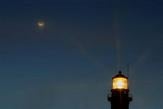These handy tips help you spend more time taking photos and less time working on the computer.
Dave Johnson
Maybe you love working with images on your PC--but if so, you're probably an exception rather than the rule. Most people I know would rather be taking pictures than fiddling with them in an image editor.
This week I've got a few tips for working faster and more efficiently with your digital photos, so you can get away from the monitor and spend more time snapping pictures.
Use a Memory Card Reader
The first accessory I recommend after buying a digital camera is a memory card reader--assuming your computer doesn't already have one built in. Rather than using the USB connection cable that came with your camera, pop out the memory card and insert it in the card reader. You will avoid running down your camera batteries while transferring your photos to the PC, and you can insert another memory card into your camera and go take more pictures while the first card is busy.
Make Your PC Photoshop Friendly
You don't need a top of the line, quad-core computer with gobs of memory to edit your photos (though it certainly doesn't hurt). Even an older computer can run a program like Adobe Photoshop Elements just fine. Just be sure to prepare your computer. Defragment your hard disks regularly; once a month is a good interval. To do that, open My Computer and right-click your hard drive. Choose Properties, select the Tools tab, and run Defrag.
There are a few things you can do in Photoshop Elements, as well. Choose Edit, Preferences, General from the menu and click Performance. If you have 2GB or more of memory, allocate at least 1GB to Photoshop. Also, if you have a second internal hard drive, designate it as your primary scratch drive, so Photoshop won't try to store temporary editing information on the same drive that Windows is using for system operations.
Tag and Organize
If you spend more time digging around folders on your hard drive looking for photos than you do editing or sharing them, it's long past time for you to tag (or keyword) them. Try a free photo organizer like Microsoft Windows Live Photo Gallery.
To learn more about tagging your photo collection, read "Organize Your Photos."
Rotate as You Go
If you've been collecting digital photos for more than a short while, you probably have a lot of images that are turned sideways, usually because the camera was rotated to the vertical "portrait" position. Many cameras automatically correct this problem, but if yours doesn't, use the Rotate button in Windows' photo viewer to fix your photos as you review them on the PC.
Many folks are reluctant to do this, thinking it reduces the image's quality, but that's usually not the case. As long as you're rotating a picture in a standard resolution (such as from a digital camera), the rotation is "lossless"--it doesn't affect photo quality at all. If you try to rotate a nonstandard image (such as one you've already cropped to an unusual size), you can have some minor image compression when the rotated photo is resaved.
Upload in Batches
I recently watched my mom upload photos to Yahoo's online photo sharing site, Flickr--one image at a time.
There's no need to waste your time like that. Most photo sharing sites make it easy to upload photos in batches these days. Flickr, for example, has the superb Flickr Uploadr, which makes sending images to the Web site as easy as drag and drop. And Windows Live Photo Gallery lets you select images directly from your PC's photo collection and post them in bulk to sites like Flickr or Windows Live Spaces.
How Do You Save Time?
Do you have handy tips for shooting, organizing, editing, and sharing photos faster or more efficiently? Send them to me, and I'll publish them in a column of reader-submitted tips soon.
Hot Pic of the Week
Get published, get famous! Each week, we select our favorite reader-submitted photo based on creativity, originality, and technique. Every month, the best of the weekly winners gets a prize valued at between $15 and $50.
Here's how to enter: Send us your photograph in JPEG format, at a resolution no higher than 640 by 480 pixels. Entries at higher resolutions will be immediately disqualified. If necessary, use an image editing program to reduce the file size of your image before e-mailing it to us. Include the title of your photo along with a short description and how you photographed it. Don't forget to send your name, e-mail address, and postal address. Before entering, please read the full description of the contest rules and regulations.
This week's Hot Pic: "Uncooperative Tree Frog," by Jeff Kraus, Orlando, Florida
Jeff says that he photographed this tree frog near his house with a Canon 30D. "He was remarkably adept at turning to face away from me every time I tripped the shutter."
This Week's Runner-Up: "There's a Moon in the House," by Jeff Gzyl, Lawrenceville, Georgia
Jeff writes: "I was taking shots of the Tybee Lighthouse with my Canon Digital Rebel, mounted on a tripod. I had a star effect filter connected to the end of lens. When I noticed the proximity of the moon, I recomposed the shot and got one of the light beams to point directly at the moon."
See all the Hot Pic of the Week photos online.
Have a digital photo question? Send me your comments, questions, and suggestions about the newsletter itself. And be sure to sign up to have the Digital Focus Newsletter e-mailed to you each week.





No comments:
Post a Comment